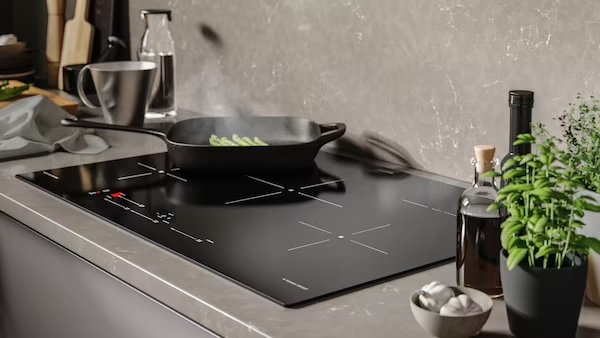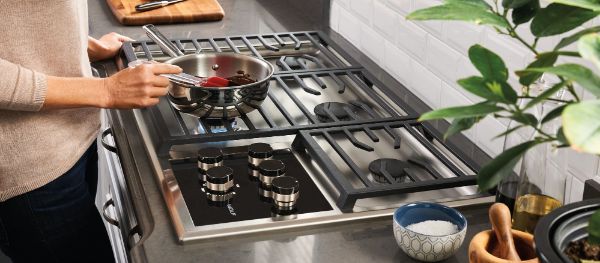Before you buy induction, just know that gas is more reliable and requires less power, while induction is faster, with a better simmer, and easier to control.
The choice between induction and gas cooking is becoming a hotly debated topic these days.
The answer is is complicated as there’s no one answer to the question, despite induction being touted as the best.
In this article, you’ll learn the difference in performance, safety and reliability between induction and gas. You’ll also learn the cons of both.
Too many articles have focused on the pros.
Table of Contents
Fuel Type Basics
Induction is magnetic heat so the electromagnets excite the molecules of the pan while the pan cooks the food.
The pan is the circuit bypassing the glass. Important detail for cleaning, venting and safety, as we’ll explain later.
Well, you know gas, because it’s a spark, igniting an oxygen and gas mixture through smaller perforations in your burner.
Performance
Almost every article you’ll read will talk about the speed of induction. They’ll reveal the results of boiling different measurements of water.
But how do they compare cooking solid food?
We test induction versus a high powered professional gas unit in searing a steak and cooking a complete pasta dinner.
Searing was two minutes faster, while the complete pasta dinner was seven minutes faster than the fastest gas cooktop.
Simmer
Induction has an instant simmer. If we look at the controls of gas versus induction that electronics are more precise.
Also, gas cannot reach lower temperatures without extinguishing. The lowest is 100 degrees from Thermador’s extra low or SKS’s ultralow simmer, versus an infinite simmer in induction.
Cleanability
Induction will be more easily cleaned. It is a smooth glass surface without the nooks in the cooktop and the gas grates of the gas unit.
Also, you don’t have to clean residue from burnt food. The heat bypasses the glass so the food doesn’t burn into the unit.
Possible exception of gas for cleaning, go to the Thermador star. It’s raised up over the surface and will clean easier underneath.
Safety
Induction will be safer. You don’t scald your hand on the cooler surface of induction, the glass does not conduct heat like electric.
You’ll feel some residual warmth from the pot to the surface.
With gas, you see the flame, but the burner is still hot after shutting off.
Kids can’t actually turn induction on either. Magnets in the burner have to sense metal to activate.
Gas diffuses heat, so you have more heat to vent. However, venting should be a more thoughtful consideration in this decision.
Both will emit potentially toxic chemicals from tiny particles like particle matter, nitrogen oxide, nitrogen dioxide, carbon monoxide and formaldehyde.
Induction will produce much less, including no carbon dioxide.
Reliability
Gas ranges are more reliable than induction at 9.4% versus 6.4% for gas range needing service in the first year.
In addition, gas is much easier to service than induction. You’ll find more service people available to fix gas than induction.
Power Requirements
Gas only uses the standard 120 volts. Electricity is rated for twelve amps or less. With induction, you’ll be using 40-50 amps for many people in condos and coops.
You may not have the available power in your unit for the added amperage.
If you live in an area with frequent power outages, you can turn on your gas range by lighting with a match.
With induction, you have to wait. It’s curious, the state leading the charge and banning gas ranges is California which has frequent power outages.
They’ll have to add 30-40 amps per household times millions of houses. Hopefully they’ll have that figured out.
Final Differences
With gas, you also have grill, griddle and wok compatibility, especially with professional range tops.
You can even buy a few with the French top to cook many different foods simultaneously at different temperatures.
Gas can be used with any surface. With induction, it has to be metallic to attract the magnetic burner.
Quick tip, take a magnet and see if it sticks.
Key Takeaways
Your decision should be based on how you cook and where you live.
Induction is a better cooktop for output simmering and overall control. It’s safer and easier to vent.
Gas is more reliable, requires less power and has more interesting models.
If I experience frequent outages, I wouldn’t be so quick to switch to induction.
Maybe this is the future.
Fisher Paykel has a combination of both gas and induction. You have the speed and control of induction with the reliability of gas. You can even cook when the power is out.
What do you think of your induction or gas cooktop?


